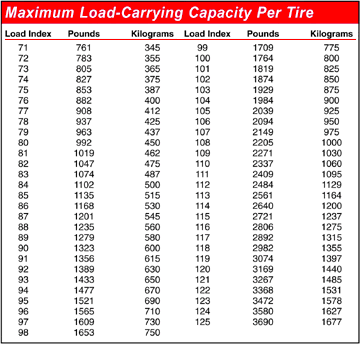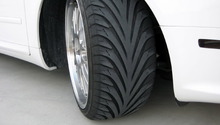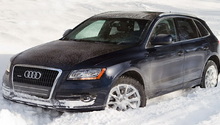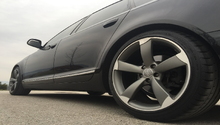Audi Q5: Tires General Information and Recommendations
Learn about optimal tire size, type, pressure and more in this informative guide.
This article applies to the Audi Q5 (2009-present).
Your tires are the most important parts of your car when driving. Tires determine how the car handles, how smooth the drive is, and how the car deals with difficult conditions like snow or rain. Different tires can serve different purposes, and the many letters and numbers attached to tires can be confusing. In this article we will break down some of the more non-obvious elements of tires, and give you all the information you need to be an informed buyer the next time you replace your tires.
Tire Size
One of the most important parts of a tire to understand is the tire size. While almost everyone knows what the diameter of their rim is, there are other numbers that are important to know as well.
- The stock tire size for a 2009 Audi Q5 Quattro without the 20-inch wheel option is: P235/60R18.
- In this tire listing, the "P" means "Passenger Car." For most vehicles this will be the standard, and in some sizes it will not be listed at all.
- Next, the number "235" refers to the tire width. From the inner sidewall to the outer sidewall is 235 millimeters.
- The number "60" is the Aspect Ratio of the tire. The lower this number, the lower the profile of the tire. A lot of sports cars use between 40 and 50 profile tires while SUVs and trucks use 60 to 75 profile tires.
- "R" in tire size refers to Radial Construction, which is the most common type of tire construction. Nearly every car on the road is equipped with radial tires. "18" is the diameter of the rim the tire is designed to fit on.

Pro Tip
Instead of "P" you may see "LT" on a tire. This means "Light Truck" and should not be installed on any car that does not specifically call for it in the owner's manual.
Speed Rating
When looking at a tire size you may see one that reads like this:
P225/50ZR18
This tire size also includes the speed rating of the tire, which refers to the maximum speed you can go on a tire before damaging it. Most tires are rated above highway speeds to make them safe to take on the highways, but if you plan on taking your car to the racetrack you may need a higher rated tire. The speed rating is usually placed next to the load index (next section) unless it is a "Z" rating, in which case it is included in the tire size like in the example above.

Pro Tip
The speed rating is NOT a suggestion to go barreling down the freeway at any speed you choose. Always obey the posted speed limit.
Load Index
The load index describes how much weight a tire is meant to hold. On a car the weight is divided into four parts, with each part going to a tire. The load index is usually found just next to the size on a tire.

Tire Pressure
Not necessarily a part of the tire itself, but just as important, is the tire pressure. Your car will have a specific tire pressure at which it runs best, and not following this tire pressure can be the difference between a pleasant drive, and frequently replacing tires that are meant to last twice as long. The recommended tire pressure is found on a sticker in your door frame.
The tires themselves will include a maximum psi reading. It is very important not to follow this number, since that will invariably mean overinflating the tires. While it is considered a "life hack" by many people to fill the tires past the recommended setting to improve fuel economy, the tires will wear out much, much faster, and may even blow out more easily. The potential savings from this trick is much less that what it will cost to replace your tires in the long run.

Tire Types
There are several different kinds of tires available on the market, and the differences can sometimes be confusing. In general you will find performance summer tires, all-season tires, and winter snow tires. Performance summer tires are designed for maximum traction on dry surfaces, and if you find yourself looking at tires with a Z speed rating, chances are that you will be looking at these. These are great tires for summer driving,especially if you drive a sportier car like the Audi S4.
The vast majority of tires you will find in service shops will be all-season tires. These tires are good in just about any weather condition, and for most commuter cars they are the recommended type. These tires will handle reasonably well in dry conditions, snow, rain, and any other situation you are likely to encounter.
Winter snow tires are recommended if you have to drive through heavy snow on a regular basis, and usually aren't necessary outside of places like Alaska and the snowier parts of Canada. These tires will not provide very good traction on dry pavement and usually carry a hefty price tag.

Frequently Asked Questions
How worn should my tires be before I have them replaced?
Your tires are considered worn out when they only have 2/32" tread remaining. A good way to test this is to place a penny upside down and see if the tread reaches Lincoln's head. If you find that the tread reaches either below or just to this point, it is time to replace your tires.
Which brand of tire works best with my car?
This is completely up to opinion. There are dozens of brands that perform very well on any car, although the top brands for the Q5 are generally Michelin, Continental, Goodyear, and Nitto. Brands like Douglas, while cheap, are not recommended for most cars.
How often should I change my tires?
The answer to this question varies by how often you drive and what your driving habits happen to be. Someone who only commutes around town at low speeds isn't going to endure the same kind of wear that someone driving at high speeds on the freeway will typically see. A good rule is to check your tread depth after about 8,000 miles and have your tires rotated to keep the wear even. Different tires will wear out at different times, so being familiar with the tire you buy is always a good idea.
Related Discussion and Site
- Calculating Tire Dimensions - Tirerack.com
- Audi Q5 OEM Tires- Audiworld.com






